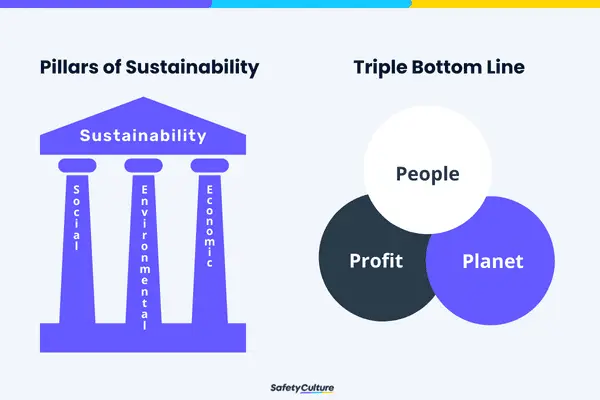What is Business Sustainability?
Business sustainability is the strategic approach of companies in doing business and creating long-term value products while ensuring that their operations and output do not negatively impact society. The general goal of a sustainable business strategy is to integrate environment and social factors into business goals, while still benefiting its stakeholders with financial gain.
A sustainable business or enterprise follows the principle of the Triple Bottom Line which is the commitment of businesses to the three pillars of sustainability referred to as planet, people, and profit.

Three Pillars of Sustainability/Triple Bottom Line | SafetyCulture
In other words, sustainability is the concept of operating business as usual while still committing to environmental and social responsibility.
Why is it Important to Businesses?
According to the research conducted by the Governance & Accountability Institute, 92% of the S&P 500 companies released a sustainability report in 2020 and based on the study conducted by KPMG, 80% of the world’s leading companies are now incorporating sustainability into their operations and goals. Meanwhile, almost a third of Europe’s largest listed companies pledged to reach net-zero by 2050.
These all show that sustainability is increasingly becoming a key priority of corporate governance and a part of their long-term objectives. But why is it really an important practice for businesses?
Improves energy efficiency and contributes to climate change goals
Reducing a company’s carbon footprint helps contribute to the common goal of lessening greenhouse gas emissions. It also helps companies commit to their energy efficiency goals and ensures that businesses consume energy responsibly.
Reduces long-term production cost
One of the primary characteristics of engaging in sustainable efforts is the capability of creating and managing products or services with longer value. Committing to sustainability is often seen as an expensive practice for businesses but the lasting result it brings helps companies maximize resources, which eventually results in lower production costs.
Promotes compliance with regulatory requirements
International business standards and industry regulations change according to the current needs of the industry and this includes policies about sustainability. Proactively and constantly engaging in sustainable strategies helps companies comply with these requirements.
Attracts customers who are committed to sustainability
According to a recent study, 85% of the world’s consumers prefer buying from ‘green businesses’ or those who use sustainable materials in their production. Companies can use this to their advantage while reaching their own sustainability goals.
Improves public image and investment opportunity
As more consumers become environmentally conscious, the companies that are known to practice sustainability are perceived more favorably. Going green shows the world that you care about factors that affect society such as the climate, proper use of resources, and equality. This can all help improve and develop your brand’s identity.
Reduces waste
Committing to sustainability also affects good waste management practices, helping companies better manage waste, conserve resources, and lessen energy use.
Increases competitive advantage
Companies that integrate sustainability into their business strategy perform better than those that don’t. Research found that a stronger Environmental, Social, and Governance (ESG) rating is associated with better financial performance and lower costs of debt and equity.
Examples of Sustainability in Business
Sustainable strategies may vary depending on the goals and key objectives of an organization. What works for a big company may not be as effective for a smaller business, and a sustainable approach for a particular industry may not be applicable to another. These attempts are largely tied to organizational values and must be tailored specifically to each unique entity with the goal to integrate sustainability with business strategies. For instance, sustainability in business can mean:
- Using sustainable materials in production or the practice of sustainable manufacturing
- Utilizing renewable energy and resources to power production facilities and reduce carbon emissions
- Engaging in waste management and water management systems to help conserve resources
- Modifying company facilities and buildings to make it more sustainable and efficient
- Going paperless to reduce unnecessary waste
- Optimizing supply chain and tailoring it to the company’s sustainable strategies
- Creating a green space or green area to help regulate air quality and temperature
How to Ensure Business Sustainability
Based on the recent studies that focus on the importance and benefits of going green, businesses should have a plan in place as a guide in reaching their sustainability goals. These strategies will serve as a standard in assessing if they were able to successfully commit to their key objectives and efforts. Below are the steps and ideas on how to maintain a sustainable business:
1. Learn about sustainability
Research about sustainability and its importance. There’s no specific strategy that fits all, so learning which sustainable efforts can work with the industry that your business is in is a good starting point.
2. Make sustainability a core principle
If the concept of sustainability is at the heart of how a business operates, this can contribute to achieving the company’s sustainability goals a little more easily.
3. Assess areas of improvement
Once you recognize what strategies are applicable to your business, evaluate the current state of the areas for improvement and work from there.
4. Find sustainable opportunities
Identify what other parts of the business can be improved and which operations can be executed more efficiently. Employee input is also valuable since they play a critical role in implementing these efforts.
5. Innovate
Innovation is at the core of making your business sustainable and company strategies may need to be changed in order to achieve the sustainability goals. From discussing best practices to discovering efficient ways of doing things, innovation ranges from simple process changes to the installation of technologies that could help maximize resources.
6. Incorporate diverse leadership
Being a sustainable business doesn’t only focus on the environment but other societal factors like equality, fair wages, and diversity. A report released in 2018 titled Better Leadership, Better World: Women Leading for the Global Goals, showed that gender equality in the workplace can help unlock more than US$12 trillion in new market value linked to the UN Sustainable Development Goals.
7. Set a long-term and attainable vision
Once you’ve identified rooms for improvement and recognized sustainable opportunities, set a target that your organization can work towards. These goals may include reducing energy consumption, implementing waste management, or utilizing solar panels for production facilities, among others.
8. Apply changes and be consistent
Ensure that the changes are implemented across your organization. Results may not be immediate so consistency is key to ensuring the plan’s effectiveness.
Create Your Own Business Sustainability Checklist
Eliminate manual tasks and streamline your operations.
Get started for FREEBest Industry Standards
Businesses can also consider proactively complying and following the best industry standards, practices, and regulations to achieve their sustainability goals. Some of these are legal requirements from regulating bodies while some are industry best practices that can help businesses accomplish their sustainable goals. Check the following and see if they apply to your organization:
Environmental, Social, Governance or ESG is an assessment of a company’s leadership and management that considers factors ranging from environmental, social, and governance. It focuses on how the executives of a company run the business and if it’s done in an ethical and fair way. As previously mentioned, a strong ESG rating is associated with higher company performance.
Energy Savings Opportunity Scheme or ESOS is a mandatory energy assessment scheme for large organizations in the UK which aims to ensure that businesses are running and consuming energy as efficiently as possible. Following this assessment can help companies achieve their energy efficiency goals.
ISO 14001 is a series of international standards designed to help organizations operate with sustainability, adhere to environmental regulations, and continuously improve processes. This also contains ISO 14001:2015 which specifies the requirements for an effective Environmental Management System (EMS).
Sustainable Manufacturing is the strategic method of creating products through economical means and using components that minimize waste and reduce negative environmental impact. This is one of the practices that businesses do to implement and practice sustainability.
Circular Economy is the optimal use and reuse of resources in the various stages throughout production chains and the systematic solution to reducing waste from being created in the first place. Companies can use this concept as a guide in accomplishing their sustainability goals.
Businesses can further observe their sustainability progress by regularly monitoring the conformance of employees and tracking sustainable implementation in facilities. This can help in proactively catching inefficient areas in operations that need to be addressed, rooms for improvement, or non-conformance with implemented changes in your organization.
All these may be daunting to manually keep track of but companies can always utilize tools that can help monitor the progress and trends of their sustainability goals in an efficient and effective manner.
Integrate ESG principles into your operations
Drive sustainable growth and create long-term value with our ESG solutions.
Explore nowPractice Business Sustainability with SafetyCulture
Leverage the use of technology in implementing your sustainability goals and objectives. SafetyCulture (formerly iAuditor) is a powerful inspection and auditing platform used by industry leaders to monitor sustainability practices in their operation. Use SafetyCulture templates and checklists to ensure that best practices are observed. Proactively identify issues and opportunities, and ensure that sustainable solutions are implemented in all processes of the organization. SafetyCulture can also help you do the following:
- Conduct regular inspections to maintain and ensure that sustainability efforts are implemented.
- Use free sustainable templates or create new ones based on your business goals and objectives.
- Directly report any important observations or hazards noted using SafetyCulture’s Issues feature.
- Automatically store a record of every inspection, issues, and corrective Actions through cloud-based recordkeeping. Safely access your data anytime, anywhere.
- Generate reports from your sustainability inspections to monitor your progress and share them with your team.




